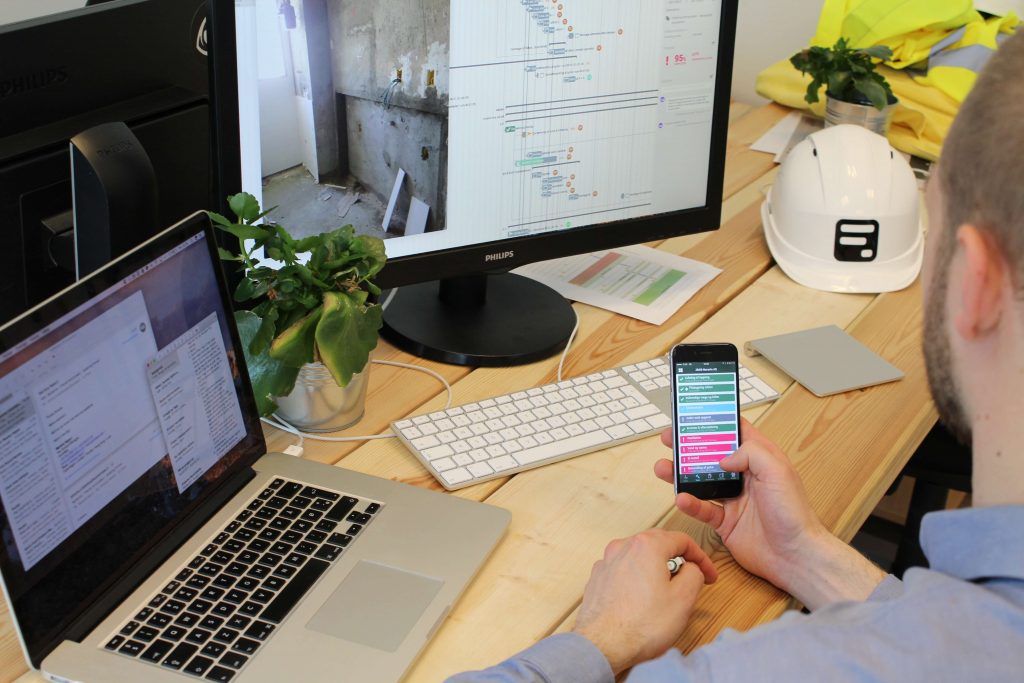How to avoid having painful delays killing a project is not an empty thought experiment – it’s a matter of choosing the right communication channel for the owner-architect-contractor triad.
The China Central Television (CCTV) Headquarters in Beijing redefined the concept of a skyscraper: it is a 234-meter loop in an earthquake prone zone. The highly unusual building is the result of multinational cooperation between Dutch architects, a Sri-Lankan-British engineer and a Chinese project manager overseeing 10,000 employees.
The whole team had to face a number of challenges: the building process required seismic stability, Beijing’s extreme heat and cold forced engineers to link the two towers at dawn, the weight of the steel could cause weight distribution issues and the local water table created its own host of problems. However the biggest challenge facing the CCTV Building project was team communication.
Read More: Construction Project Management Processes: Everything You Need To Know
Organizing 10,000 people into a successful team requires constant undivided attention to detail combined with superhuman adherence to project goals. The ability to clearly give the team their task and streamline communication between all parties who might not even speak the same language turns a project manager into an orchestra conductor.
Beijing caught its first glimpse of CCTV Headquarters in May, 2012. It took 8 years to build one of the world’s most distinctive buildings. OMA, the Dutch architecture agency, won the design in December 2002 and China’s biggest contractor, China State Construction and Engineering Corporation (CSCEC), broke ground in September, 2004. Almost two years of careful planning allowed the team to take on all the risks of the environment and even overcome a fire in an adjacent building in 2009.
Turning a team into a well oiled machine is the unsung secret sauce behind any successful construction company. Regardless of whether it’s a small scale independent contractor or CSCEC, organizing a team requires putting out fires before they start. Teamwork relies on two skills that a project manager needs to master: the first is finding the best way to communicate the architect and owner’s ideas to the construction workers and the second is to relay feedback from the building and engineering teams to the owner.
Mastering communication on a construction site can be tricky: it is a high risk area where a simple misunderstanding could fully be a matter of life and death. At the least, misunderstandings are a source of delays, expense overruns and frustration. However, armed with the right online tool-set, the whole process could be easier than it appears at first glance.
How to communicate the designer’s ideas to the team
The Construction Media Index report recorded telephone interviews with more than a thousand contractors to determine what they were looking for on the Internet. What seems like an annual update of the top ten best project management apps or the most comprehensive CRM systems, is actually a digest of ready-to-implement ideas for bridging the gap between a designer’s vision and the team’s scope of work. Crucial insights from experienced contractors reveal online tricks that could speed up the staging process.

One of the main findings concerns search engines: there is a considerable decline in search engine use to find information about materials and supplies. Professional forums are more frequently visited in the quest for a project solution or professional advice.
[clickToTweet tweet=”Check these great tips for optimizing #project #communication ️” quote=”Check these great tips for optimizing #project #communication ️”]
Another important part of the study revealed that social networks, such as Facebook, Twitter, Snapchat are increasingly treated as a work tool. Due to online availability, professional communities have become stronger. Social media outreach is a primary channel of communication, particularly for headhunting and keeping up with the latest ideas. The report shows that age and business size does not have a significant bearing on what communication channels are used.
While working with designers and setting the scope of a project, don’t hesitate to seek professional guidance in online communities. Avoid search engines as your first reaction; their breadcrumbs do not always lead in the right direction. Post your question on professional forums or on social media, use videos and a lot of visuals in your posts and presentations. That way you’ll be providing professionally approved, concrete guidelines for your team, while building a strong foundation for the next stage of the project.
How to report results
The Construction Specification Institute (CSI) conducted a study on the methods of successful teamwork and determined that the key to success in most teams is timely communication. A variety of web-based services, email and social media allow contractors to make real-time communication the undeniable principle of project communication.

Daily reports, meetings, setting tasks and tracking progress is now available in most team collaboration apps. Simply choose an intuitive product that suits your demands. A web-based service also helps resist the temptation of solving tasks via conversation and not documenting the results. Keeping records pays off during disputes and whenever you need to deliver news to 10,000 employees, like project manager Dongmei Yao had to do during the CCTV Headquarters project. Let the scale of the project be the decisive factor in choosing your online helper: systems that work perfectly for teams of 10-12 employees might not be able to process the massive data requirements for an innovative skyscraper.
Another important factor in choosing a digital assistant is rich media support. Using images and video changes the daily routine of team collaboration. For example, a daily report for a task in progress takes a couple of minutes when a contractor can simply take a picture with his smartphone, upload it, add comments and send it to the owner instead of struggling with the correct description at the end of an exhausting day.
Don’t forget to make sure the solution you are about to use integrates with the apps and systems your client already uses. All parties involved in the project might already have a CRM, project management app and cloud storage platform that sync up.
Look for an app with different kinds of privacy settings: from securing certain files/tasks/issues with a unique password to adding a level of access to the whole project. Assigning roles to project members, such as owner, administrator or team member, could help you protect sensitive data while making sure all the right people have all of the access they need to complete their tasks.
Summary
Before dealing with the technical issues, make sure you’ve built a strong foundation for a future project: a combo of an intuitive online tool and smart online strategies. Four factors to keep in mind while choosing a digital solution: easy-to-use task management, rich media support, integrations with other services and customizable privacy settings. Professional guidance from forums and social media is a powerful tool – don’t be afraid to use it and remember to illustrate the content you share with the owner, architect or your team.
About the author: Irene Samozdran is a marketing writer at PDFfiller, Inc – an all-in-one web-based PDF editor, eSignature solution and fillable form builder that runs on desktop browsers as well as iOS and Android apps.




